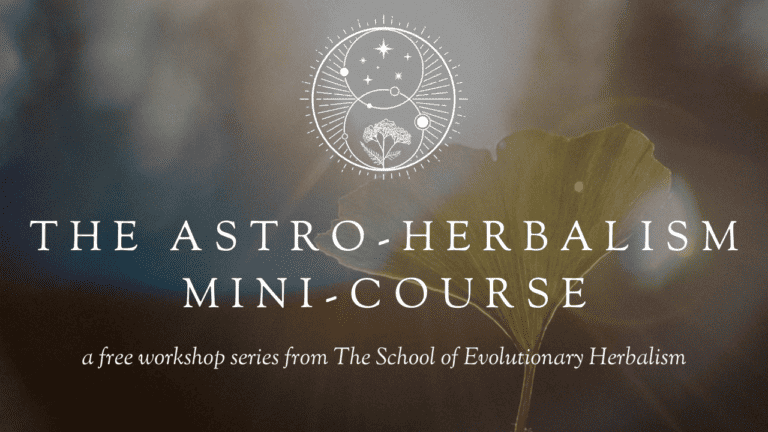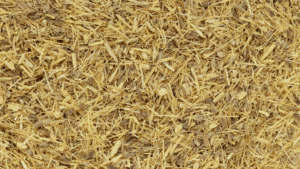The term “holistic” is buzzing in the holistic healthcare system today, but what does this word really mean?
A holistic practitioner, according to the Evolutionary Herbalism model, is someone who unites the physical, energetic and spiritual properties of a plant with these aspects of a person to facilitate deep, transformational healing.
Medical astrology is one of the most potent tools you can use to develop a refined, precise, and effective system of holistic herbal medicine that addresses the whole person.
In today’s blog post, you’ll learn:
- Why practicing holistic herbalism is so important
- The history and significance of medical astrology
- Ways that medical astrology can transform your practice
- How to use the natal chart as a holistic assessment tool
Table of Contents
Are you a holistic practitioner?
While the answer might seem obvious if you’re an herbalist, let’s consider what the word holistic really means and how society has come to use it.
If you Google search for natural products or services, you’ll likely see the term “holistic” listed over and over again in your search results. After all, it is a buzzword! However, does adding green tea extract to a shampoo truly really mean it’s holistic? How about using essential oils during a massage?
If you think about it, Western society has commercialized this term to mean that a product or service contains something natural. While this is one way of defining the word, I like to use a different definition.
I believe that a holistic practitioner isn’t defined by the products they use, but in the process they follow to select them. For example, if you suggest the same nervine herb to every anxious person you meet, that’s not holistic herbalism. However, if you take the time to sit with them, do a comprehensive assessment, and then select a nervine herb–that’s holistic herbalism at work.
In the Evolutionary Herbalism model, a truly holistic practitioner is one who knows how to unite the physical, energetic, and spiritual properties of a plant together with these aspects of a person. By selecting and using herbs in this way, you can be a conduit for someone’s healing.
This is easier said than done–after all, people and plants are complex. Understanding one alone is already a mammoth task, let alone how they might work together to provide a synergistic result. Medical astrology is an organized system that can help you calculate likely influences between people and plants, and even predict potential health outcomes in your practice. Altogether, it’s a powerful tool to have in your belt as a holistic herbalist.
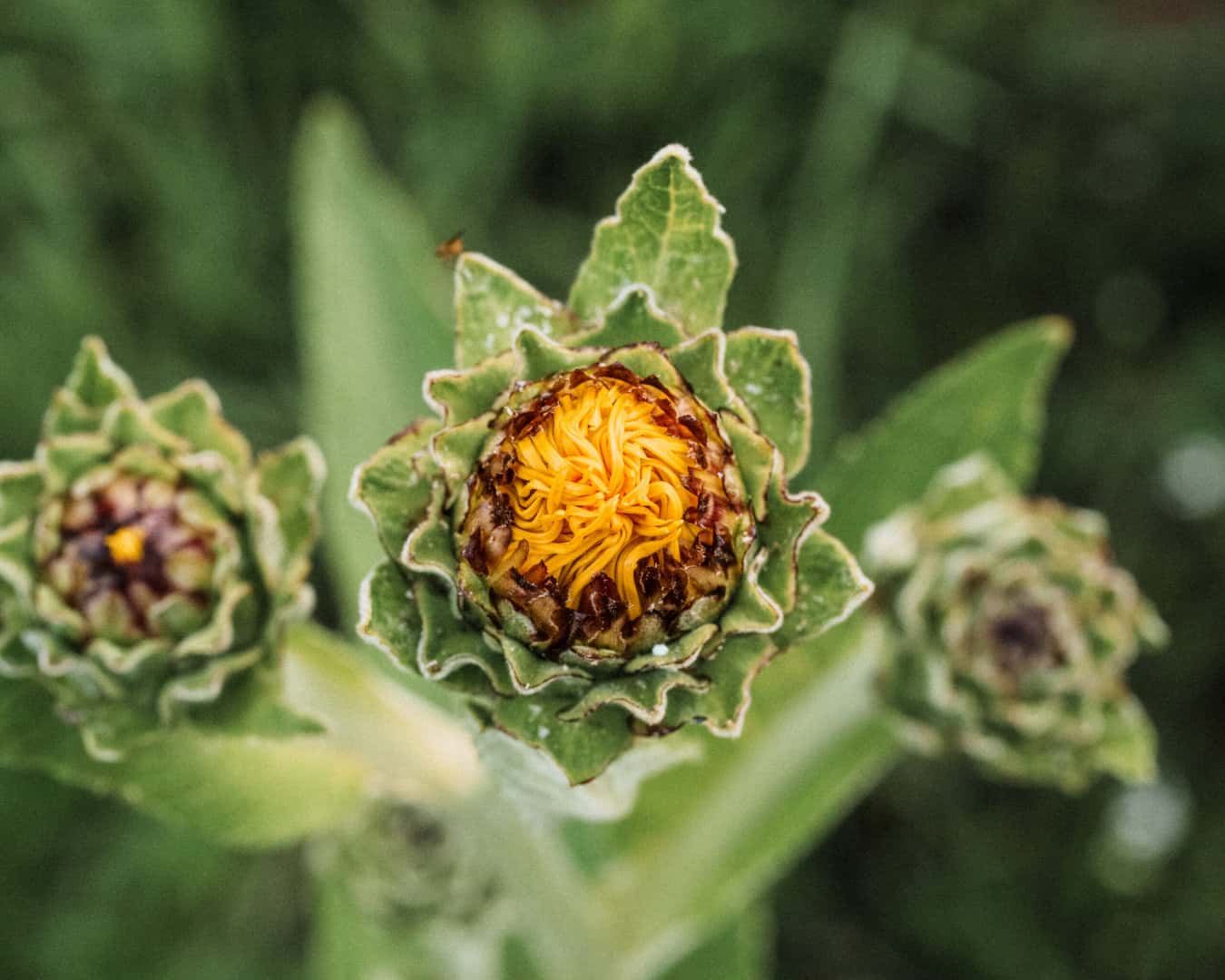
Medical Astrology
During the Renaissance era, herbalists throughout Europe studied astrology and used the knowledge of the planets to better understand the plants. They also used this information to create effective formulations, prevent disease, and determine constitutions. This practice wasn’t exclusive to herbalists alone but was considered essential training for all medical physicians.
Despite its absence in conventional medical practice today, it’s my hope and mission to revitalize and share the true roots of astrology, which is an ancient system that encapsulates within it all of the archetypes found in nature.
Medical astrology is an intricate system that maps connections and tensions between a person and a plant. To find these patterns, we use the archetypes expressed through the planets and signs of the zodiac. Through studying these astrological archetypes, you gain a deeper understanding of the plants and how to use them for transformative healing.
Medical astrology is an incredibly powerful tool that can transform your herbalism practice and make it one that is truly holistic. After all, you can’t get much more “whole-istic” than considering the cosmos in how you work with people and plants! This tradition offers a strong framework for you to operate from, assisting you in understanding the whole person, the whole plant, and how these two entities interact to produce a synergistic response.
While it’s easy to find your birth chart, also known as the natal chart, it takes time to learn how to read it. For those unfamiliar with this term, your birth chart is a visual representation of where the planets and signs of these archetypal forces were present at the time of your birth. These forces impress their influence on you, not just in personality, but in your corporeal form, by influencing your constitution, organ system strengths, weaknesses, and your predispositions to disease and imbalance.
Your birth chart indicates how your organ systems communicate with each other to affect the body as a whole. By learning how to decipher your chart, you can receive tremendous insight into your body’s natural tendencies of excesses or deficiencies. Using this information, you can take steps to restore your balance, such as eating a diet, taking herbs, and practicing lifestyle habits that recalibrate your constitution. Astrology is a whole language of its own, so start slow and enjoy the process as you develop your fluency.
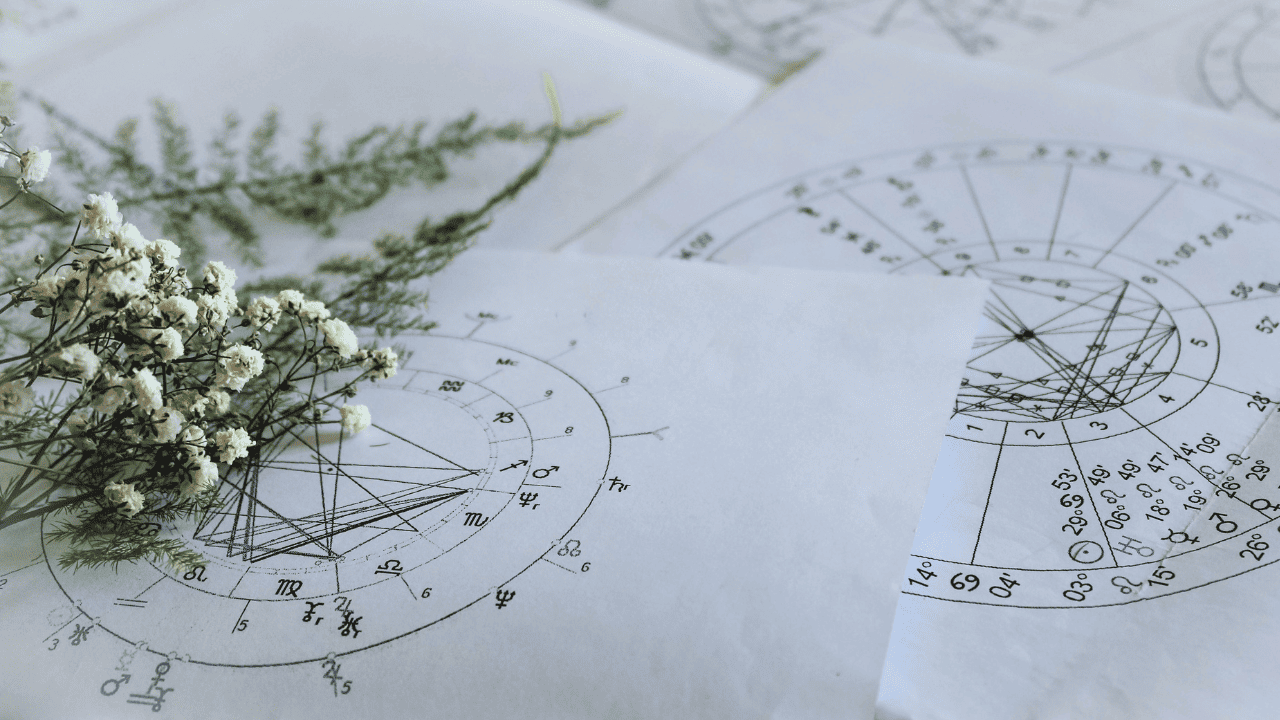
Blueprint of the Soul
The natal chart is the blueprint of the soul. Just as you can assess the birth chart to understand your physical tendencies, you can use it to gain a glimpse into the workings of your mind, heart, and lens through which you see the world.
Your birth chart grants you the ability to see the archetypal forces of nature reflected within yourself. When analyzed, it can reveal areas of your life that are well developed and others that require more work.
If you take a glance at your natal chart, you’ll notice that there are twelve sections divided within a wheel. These sections are known as the “twelve houses.” Each of these governs a different aspect of your life, from relationships and home life, to your work, career, and spiritual self. From them, you can glean insight towards these parts of your life by seeing which zodiac signs and planets are placed in them and by viewing the entire chart as a whole.
Another way you can gain insight into the ways that the planets influence your life is by viewing the zodiac signs within your chart. There are seven inner planets, which include the Sun, Moon, Mercury, Venus, Mars, Jupiter, and Saturn, and three outer planets: Uranus, Neptune, and Pluto. Each planet possesses two zodiac signs empathetic to it and channels its energies smoothly through, known as the ruler and sign of exaltation. Conversely, they possess two that struggle to express the planetary force, resulting in the planet’s detriment and fall.
In short, this is one simple way to determine if a particular planetary power is strengthened or weakened by its placement within the chart. Planets in their sign of rulership or exaltation are naturally stronger (potentially to a point of excess though) and planets in their sign of detriment or fall are naturally weaker and more deficient.
Here’s a table breaking down the planets and their signs of rulership, exaltation, detriment, and fall:
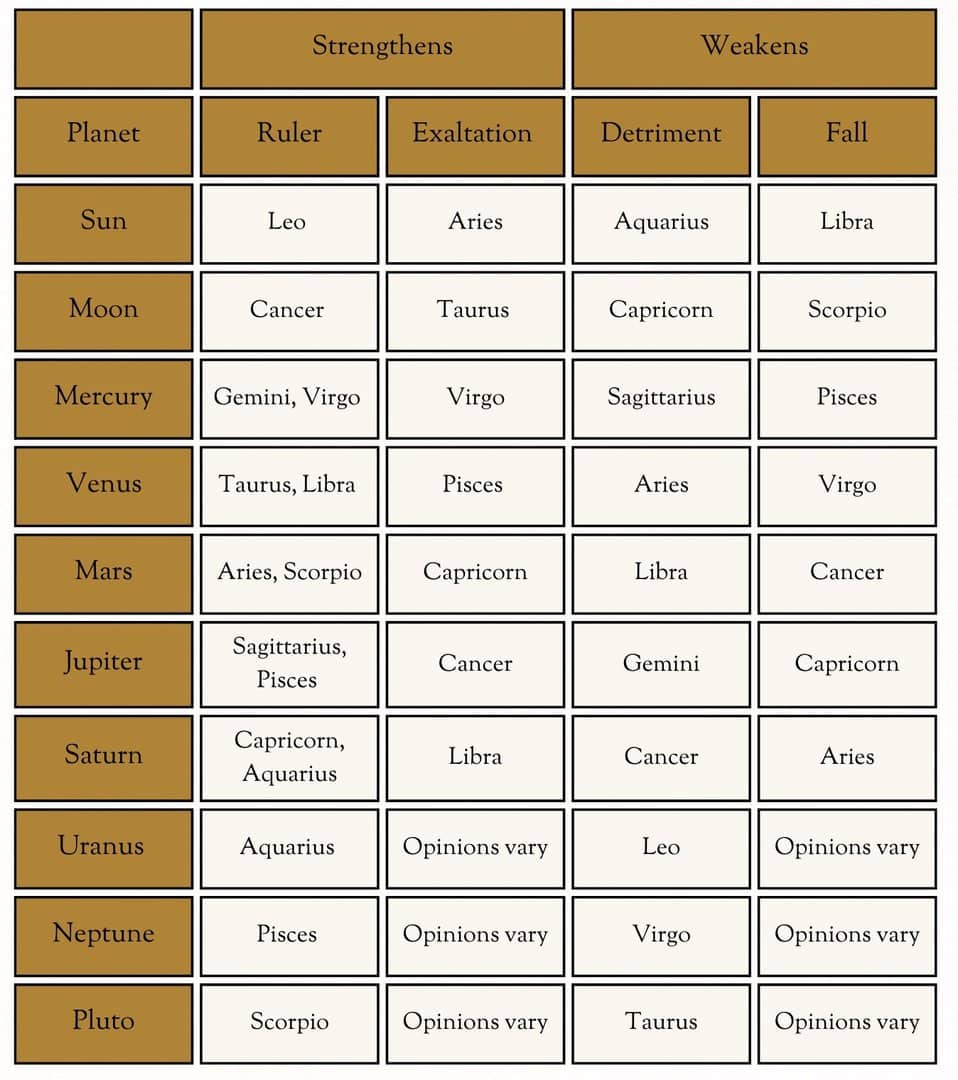
A simple way to remember this, is the sign of detriment is always directly opposite to the sign of rulership. And the sign of fall is always opposite the sign of exaltation. So if you can remember one, you already got the other!
To illustrate, Mercury rules communication and the clear expression and integration of ideas. Thus, if you have Mercury’s in it’s sign of rulership, such as Virgo or Gemini, you might have great communication skills, a verbose vocabulary, and the natural ability to express yourself clearly. You might also absorb knowledge easily, leading to quick learning. However, if this placement is in its detriment or fall, such as Pisces or Sagittarius, you may struggle to communicate well and need to work on this part of your life.
But a key thing here, especially if these planets are in important houses of health (such as the first, sixth, eighth, or twelfth houses), then this could translate into potential health concerns. With Mercury in a sign of detriment or fall, it’s possible there may be a weakness in the lungs and respiratory system, or possibly an element of the nervous system, as these are primary organ system rulerships of Mercury.
You can see this express itself again with Venus, the planet that influences your ability to connect with people throughout your life and build relationships with others. If this planet is in the sign it is most at home in, such as Taurus or Libra, you might have an easy time bonding with others and building meaningful connections. However, if its placement is in its detriment or fall, such as Aries or Virgo, you might struggle with relating to others and building deep or long-lasting bonds and relationships. Additionally, it might also feel challenging to maintain harmony with the people in your life.
Instead of looking at your natal chart and feeling that you are at the whims of it, you can use this information to rise above patterns and tendencies that do not serve you and take the necessary steps to actualize your potential here on Earth. This is obviously very simplified astrology, but if you’re just getting started, keeping it simple is preferable, otherwise it’s easy to get overwhelmed and confused by all the nuances and specificities in astrology.
This simple way of looking at what planets might be strong or weak is an excellent starting point for getting a sense for how the body is uniquely put together with its inherent potential predispositions for health concerns that can be preventatively addressed with herbal medicines.

A Cosmic Viewpoint
People often use different lenses for understanding varying facets of a plant. You may use one to view the chemical properties of a plant along with another for the psychospiritual qualities and a third for viewing its relationship to a pathological process.
With so many perspectives, it can be hard to view the plant as a unified whole. However, with medical astrology, you’ll see that chemistry isn’t separate from spirit, and that the body and soul of a plant and person are one. It provides a singular system that bonds these facets together, producing a bird’s eye view of the constellation of factors that make up your being. There’s an essence within a plant that interacts with the essence of a person to bring about healing, and that impacts the entirety of your being.
As a holistic herbalist, it’s important to address the complex layers that exist within a person. The same is true with the plants. However, sometimes it’s hard to see how numerous symptoms relate to each other and you may end up using different herbal approaches to address each complaint.
For example, if you have a client experiencing heartburn, you might focus on herbs that soothe and coat the esophageal lining, such as Marshmallow (Althaea officinalis), using the biochemical approach to herbalism. If they are also experiencing grief and a heavy heart, you might suggest Borage (Borago officinalis) flower essence to comfort the spirit.
While practicing in this fashion is a valid form of herbalism and can lead to great results, it lacks the cohesiveness that medical astrology provides. Through the application of this system, you’ll be able to effectively bridge these seemingly separate parts together. In the example above, perhaps we see in the chart that Mars (heat, burning, inflammation, pain) is in a difficult position in relation to Cancer and the Moon (rulers of the stomach). This could indicate heartburn, but could also lend insights into possible psycho-spiritual associations to the physical affliction. In this case, perhaps there’s a conflict in the home or issues associated with the person’s mother, two qualities associated with Cancer and the Moon.
Thus your herbal selections would go towards tempering the excessively hot Mars with cooling, soothing, relaxing remedies of Venus and moistening remedies of the Moon, while at the same time addressing the more esoteric parts of the healing process.
As an herbalist, the more tools you have in your kit, the better. Many practitioners rely entirely on intake as a means of obtaining information alongside pulse and tongue assessments, facial diagnostics, and iridology. Medical astrology offers you a cosmic viewpoint of people and plants. It reveals how the body, mind, and soul operate as one and how to connect the oneness of a person with the oneness of a plant and weaves together its different aspects to form a cohesive picture.
For example, if you have a client experiencing heartburn, you might focus on herbs that soothe and coat the esophageal lining, such as Marshmallow (Althaea officinalis), using the biochemical approach to herbalism. If they are also experiencing grief and a heavy heart, you might suggest Borage (Borago officinalis) flower essence to comfort the spirit.
While practicing in this fashion is a valid form of herbalism and can lead to great results, it lacks the cohesiveness that medical astrology provides. Through the application of this system, you’ll be able to effectively bridge these seemingly separate parts together. In the example above, perhaps we see in the chart that Mars (heat, burning, inflammation, pain) is in a difficult position in relation to Cancer and the Moon (rulers of the stomach). This could indicate heartburn, but could also lend insights into possible psycho-spiritual associations to the physical affliction. In this case, perhaps there’s a conflict in the home or issues associated with the person’s mother, two qualities associated with Cancer and the Moon.
Thus your herbal selections would go towards tempering the excessively hot Mars with cooling, soothing, relaxing remedies of Venus and moistening remedies of the Moon, while at the same time addressing the more esoteric parts of the healing process.
As an herbalist, the more tools you have in your kit, the better. Many practitioners rely entirely on intake as a means of obtaining information alongside pulse and tongue assessments, facial diagnostics, and iridology. Medical astrology offers you a cosmic viewpoint of people and plants. It reveals how the body, mind, and soul operate as one and how to connect the oneness of a person with the oneness of a plant and weaves together its different aspects to form a cohesive picture.
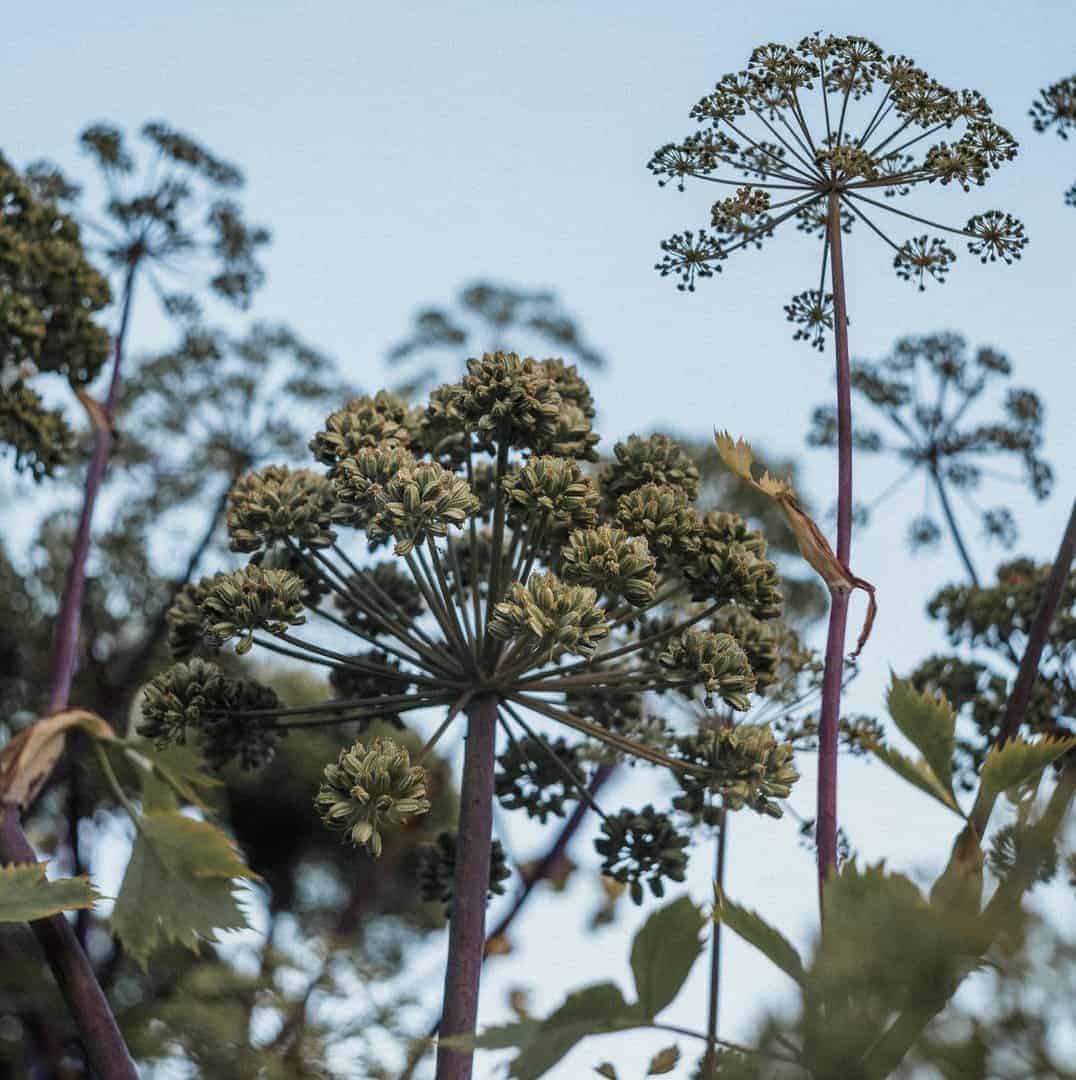
A Holistic System
The word holistic is easy to claim but difficult to live up to. There are a multitude of levels to a single person and plant, and connecting them can feel daunting, especially if you don’t have a system to provide structure to this process.
Although you can study herbs in a compartmentalized fashion, dividing the subjects by the plants’ biochemical compounds, herbal actions, and psychospiritual properties, it results in a fractured perspective of the plant. Instead of studying herbalism and the human body through random memorization, medical astrology provides you with an overarching structure, thereby funnelling the information to form a singular harmonious picture.
Medical astrology is one of the most potent tools you can use to develop a holistic herbalism practice that connects all of the facets of someone and provides deep healing on every level.
The Astro-Herbalism Mini-Course
Learn more about Medical Astrology’s insights into Holistic Herbalism inside the FREE Astro-Herbalism Mini-Course landing in your inbox on February 20th. Be sure to save the date and join the waitlist below for The Astro-Herbalism Mini-Course.


